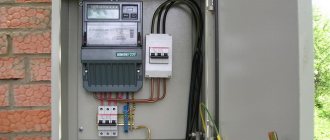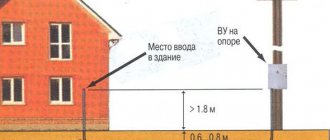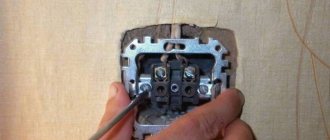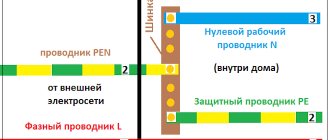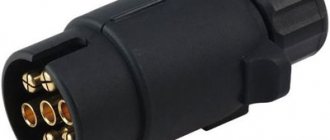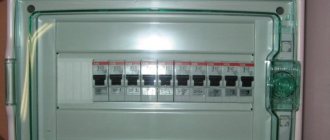Even the simplest garage needs lighting, but if the wiring is done in a hurry, it would be unreasonable to expect it to be reliable and fireproof. When creating proper working conditions in this room, one must not neglect the rules for working with electrical wiring, otherwise the consequences can be the most unpredictable. In this article we will tell you how to do electrical wiring in the garage with your own hands, adhering to the standards and regulations.
Legal aspects of connecting a garage to the electrical network
Unauthorized connection to a neighbor's wiring or power line can result in a heavy fine and will be detected by electrical network workers. To avoid trouble, it is better to perform the procedure officially. After connecting the electricity, the garage owner must fill out documents and pay for the energy consumed.
Regulatory acts
The supply of electricity to the garage is carried out in accordance with the Rules established by Decree of the Government of the Russian Federation No. 861 dated December 27, 2004 (as amended on October 29, 2021).
In addition, by Decree of the Government of the Russian Federation No. 262 of March 10, 2020, a number of measures were introduced that allowed:
- Apply for connection to the power grid using the online method. Payment for the service is also carried out remotely.
- Reduce costs, because installation of the metering device is carried out at the expense of the network organization.
- Reduce the time required to complete the service registration stages because:
- connection is carried out only on the basis of a paid invoice;
- a power supply agreement is concluded only with a network organization;
- Signing of work completion certificates on the part of the consumer is not required.
Required Permissions
First of all, the owner of the garage must have documents confirming ownership of the building.
In addition, to supply electricity to the garage, permission from Rosseti will be required. Obtaining such a document is necessary to determine the possibility of connection, the lack of connection of the consumer to the national power grid, etc. You need to submit the following to your nearest power supply office:
- a copy of the garage owner's passport;
- a copy of the title deed;
- copy of TIN;
- a list of all devices available in the garage, indicating their power;
- technical documents for the garage;
- construction plan, which indicates: the location of electricity poles, gas, water and sewerage pipelines and the places where the wiring is installed;
- calculation of total energy consumption.
In 2022, the issue of permission to connect electricity to the garage is decided by the local electricity network organization.
Requirements for electrification
The technical conditions necessary to connect the garage to the electrical network are determined by Rosseti after drawing up an application from the consumer. This information will be sent to your “Personal Account” within 10 business days from the date of the request to join. Only after all requirements have been met and the invoice has been paid, the connection agreement is considered concluded.
Bottom line
As a result, it is worth paying a little attention to safety precautions. When performing work, it is imperative to adhere to the requirements below.
- There is no need to rush, because the main thing when working with electricity is safety.
- Any manipulations involving electric current (even a banal replacement of a light bulb or socket) should only be carried out in the absence of voltage. For this purpose, you can unscrew the plugs (if you are still using them) or the circuit breakers on the switchboard.
- For work at height, trestles or platforms should be used (no barrels, chairs placed on tables, or similar structures).
- Shoes and clothing should be as comfortable as possible so that body movements are not hampered.
- The tools used must be intact and - more importantly - have an insulated handle. The same applies to electrical equipment.
And remember: if you install the wiring correctly, it is guaranteed to serve you for at least 30 years.
Add ProCrossovers to your favorites
Types of garages and features of their connection
Tariffs and the method of connection to the electrical grid depend on whether the garage is part of a cooperative or an individual building.
Cooperative
The easiest way to legally install electricity is if the garage is part of a cooperative. Then you need to contact the chairman and write an application to connect to the network. An electrician from the cooperative will come to the garage and evaluate the possibility of connection and the necessary materials. After this, he will connect the individual meter to the general distribution board and seal it.
Collective owners (garage cooperatives, gardening partnerships, etc.) pay for electricity at a tariff that differs from the standard for private owners. Therefore, it is impossible to connect independently of other members of society.
On a private plot
To illuminate an individual garage, you need to fill out an application on the Rosseti portal through the “Personal Account”. To do this, you will need to go through the registration procedure at portal-tp.rf, indicating SNILS, INN and attaching an electronic copy of your passport.
Scheme of interaction between participants in the process of technological connection of an individual garage to a power line:
- Identify a nearby network organization. The easiest way to do this is to go to the Rosseti portal, where there is a map showing all the points. You can also obtain this information from your local government. In accordance with clause 8 of the Rules, the choice of the network organization that will connect the garage to the network is made by the consumer himself before submitting an application for electricity.
- Submit an application for garage electrification. This is done through the “Personal Account” on the portal-tp.rf website or at the Central Operations Center, Distribution Zone.
- Examine the documents received in the consumer’s “Personal Account” on the Rosseti portal:
- conditions for connection to the power grid;
- an invoice for payment;
- technical specifications;
- instructions for the safe connection of power receiving devices;
- draft energy supply agreement;
- name and payment details of the guaranteeing supplier;
- applicant's personal account number.
After this you need to do the following:
- Pay the connection invoice within 5 days from the date of receipt.
- Review the notification from the energy supply organization in your “Personal Account”, which will be sent 2 business days after payment of the bill. The contract for connecting electricity is considered concluded.
- Provide access to representatives of power grids and, together with them, carry out the actual connection to electricity within 10 days from the date of completion of all necessary actions on your part.
- Familiarize yourself with the act of connecting to the power grid, drawn up by a representative of the law enforcement agency. The document will be posted in your “Personal Account”. From the moment it is signed, the organization selling electricity will charge the payment.
K-BEGEMOT › Blog › Light in the garage for 550 rubles from IDGC.
This is not just a post. This is a whole epic. A saga, you might say. It all started simply: the garage I bought was located in GSK, it had light from the cooperative. I paid according to the meter and didn’t worry about what or how. But... the chairman died, and his son took his place. And so it began... In January, the theft of electricity and hellish unaccounted expenses on the cooperative meter were revealed. Since the members of the GSK are mostly boys 60+, and the new chairman turned out to be nothing, I had to move my crazy work schedule and take power into my own hands. First, pay off someone else’s debt, and then force all would-be cooperators to change their meters and put them on the wall of the garage. By April, with grief, they did it. Motivation: I couldn’t leave the garage without light. Firstly, an alarm system, and secondly... Well, what normal guy doesn’t do some tinkering in the garage? What about without light? While the meters were being taken out, it turned out that the common wire had almost decomposed into atoms, the insulation was crumbling like dry cookies. What to do? Right! To extort money from members of the cooperative to replace the wire. With great difficulty I collected the money and replaced the wire. Do you think that's all? You are wrong. Everything is just beginning))) While they were changing the wire and putting things in order in the accounting (May 2018), it turned out... that GSK had sunk into summer. This shady chairman, as it turned out, did not submit reports to the tax office and the legal entity was closed. This means: 1) the land is no longer leased, 2) the power supply is disconnected. Both the first and the second with far-reaching consequences... I ran to register the land. By the way, I tried to take some members of the cooperative with me to make it more fun. But, as it turned out, many of them are not capable of anything more than just babbling on the rubble. In addition, a lot of interesting things were revealed: some areas were demarcated in such a way that they simply crawled over each other. I was incredibly lucky: my coordinates did not interfere with anyone... It took several months to privatize the land. Having registered my corner as final property, I exhaled a little (but in vain) and went to IDGC to arrange a new technological connection for electricity individually for myself. But it was not there. There they told me that due to the fact that my documents say “GSK” they will not connect the light to me. All arguments that GSK no longer exists have yielded no results. Having made a couple more attempts at such trips, I encountered rudeness and was sent away. Offended. I Googled and found out that there are no problems with this everywhere. People calmly connect both to the GSC and individually, only in our hole the evolution of consciousness has passed by. I decided that I wouldn’t leave it like that. In the process of studying the issue, I found out that there is a regulation for energy workers - this is a hotline number. By the way, here it is: 88005050115. I called and also wrote to their website. And... a week later my phone simply melted from their calls with an offer to connect the light for 550 rubles. Well, it didn’t take long to persuade me. By the way, you should have seen with what a hateful light in their eyes they smiled at me when the contract was drawn up))) I got the impression that they screwed up the figs not only in their pockets, but also with their toes in their shoes))) well, it’s okay, we’re not proud, we’ll endure it . There would be light. However, when I came home and carefully read the technical conditions, I was horrified... In addition to the metering station, I needed to lay 50 (!) meters of line, since for some reason they placed their last pole not on the border of my site, but on the border of the former GSK. However, they offered me to solve all these difficulties for (just don’t fall) 160 thousand (!). Well, what is this?.. Again, jumps and runs through the offices. Again explaining the laws to those who were supposed to explain them to me! But hurray, it worked. The pillar is on the border of my land. The technical conditions have changed. Next came a tedious 4 months of waiting. They did it, as usual, on the penultimate day, and on February 5th the work was completed. I assembled the metering board myself. And don’t believe that this should be done by a specialist. organization. This is not in the law. They still come to check and test it later. Of course, before this I had to thoroughly surf the Internet and consult with specialists! Collected, accepted. Another week and a half and... an agreement with Energosbyt, and the light bulb comes on! All.
And now the moral of the story. 1. Do not believe when they say that individual electricity cannot be installed in the garage. Can. But provided that the land is your property. 2) Don’t believe it when they say it’s insanely expensive. 550 rubles (specifications) + iron (around 3-4 sput), plus tests (3 sput). All. But this is, of course, if your hands grow from the right place and you have time to do the installation yourself. 3) Don’t believe it when they say that electric networks are a state with its own laws that doesn’t care about everyone and there is no government for them. Easy: hotline number - 88005050115
Features of garage lighting
If a garage is built on your own site, where there is already a house connected to electricity, then it is not difficult to connect a power cable to it. However, you will still have to install a separate distribution panel.
To account for consumed electricity, you need to connect an electric meter. There are 2 options for placing the device: on the garage wall or on a pole. Since in the first case the meter is often damaged by vandals, it is better to place it on a pole, wiring it in metal pipes or metal hoses.
Selection of lamps
It is better to choose fluorescent lamps, because... Incandescent lamps can explode from gasoline vapors. Halogen light sources can be used.
Number of lighting fixtures
Since there is no solar lighting in the garage, you should mount lamps where they are most needed: above the gate, workbench, tool shelves.
The most common layout of lighting fixtures looks like this:
- in the center – 1 large lamp for general lighting;
- lamps at the gate – 2 pcs.;
- above the workbench – 1 lamp;
- above the shelves with tools - 1 lamp.
Preventing short circuits
This means, for example, that the installed electrical equipment must be reliably protected from
- Short circuits;
- Melting;
- Spontaneous combustion;
- Getting wet due to precipitation.
What you need to do the work yourself
You can connect the electrical network with your own hands only if the total consumption is below 15 kW. You must first purchase an electric meter, cable and electrical installation products - sockets, switches, circuit breakers and RCDs.
All devices are selected depending on power consumption. Lamps are purchased in accordance with the planned scheme. In addition, you will need electrical tape and rubber gloves.
For a 220 V network, you will need a 50 A electrical panel to provide a load current reserve. It is better to place it next to the front door.
How to properly connect an RCD
The RCD is installed on the power supply line of power outlets in such a way that not only the phase, but also the zero is switched through it. Only in this case does it perform its differential function and compare the incoming and outgoing currents. Based on this comparison, the device generates a difference signal that controls disconnection of the line from the load.
A residual current device (RCD) can be connected both before and after the machine. Both options will be correct; the RCD will protect the electrical circuit from leakage currents in both cases.
When switching wires, their ends coming from the machine are connected to the upper terminals of the RCD housing. Conductors are removed from the lower contacts and enter the linear circuit and then into the load.
Drawing up a wiring diagram
The wiring diagram in the garage is no different from the wiring in an apartment or private house. Any owner can complete this task independently, because... it's not complicated. But electrical wiring must be not only functional, but also safe.
To draw an electrical wiring diagram, first select a point on the garage wall for the entry of the power cable and a location for installing the distribution panel. After this, the drawing indicates the most suitable points for installing sockets, switches and lamps. The last stage is the correct connection of the elements with lines indicating cable laying.
The main rules for electrical wiring:
- The power cable is always laid only vertically or horizontally. Do not place the wire at an angle to another area.
- The cable is laid at a distance of at least 100 mm from the ceiling, 150-200 mm from corners, door and window openings, and heating radiators.
- Sockets should be at a height of 500-600 mm from the floor. On average, their number is taken to be 1 device for every 6 m² or one for every 4 linear meters. The installation height of switches from the floor is 1.5 m, the distance from the door jambs is 0.15 m.
- All electrical devices must be protected from dust and moisture, i.e., comply with protection class IP44.
Calculation of the quantity of materials
How many machines, meters of wire, junction boxes and fasteners, as well as lamps are needed is determined based on a pre-drawn diagram. The number of outlets depends on the planned ease of use and the presence of functional areas in the garage.
The minimum required quantity is 2; ideally, there should be an outlet on each wall where electrical equipment will be connected to it. It is permissible to install a block of several network sockets, this will allow you to simultaneously power several units of consumers from one point. All connections are parallel. Cable consumption is determined by the length of the straight sections, taking into account the roundings when laying in the sleeve and a small margin within 10%.
For a single-phase network with grounding, take a 3-core cable that stretches from the junction box to the outlet. It is better to avoid splices by using whole pieces: in the humid environment of a garage, every extra joint will be a source of problems.
Ceiling lamps can be mounted on a stretched steel wire, so there will be no problem with their installation.
Before starting the calculation, it’s a good idea to take measurements from the walls (length and width), so that you can then place energy analysis points on the plan, and only after that determine the cable consumption. Grounding can be laid with a separate bus of larger cross-section, but a standard 3-core cable is more often used.
Counter selection
The choice of meter is important, because the payment for consumed electricity depends on the correctness of the readings of this device.
Most often, induction devices are installed in garages. They are reliable and durable. But their disadvantage is the low measurement accuracy, which can lead to overpayment for electricity. Electronic devices are more accurate and more compact, but somewhat more expensive.
Basic requirements for an electric meter:
- Possibility of use in unheated rooms.
- Sufficient power. It is calculated based on the total electricity consumption of all devices. Most often, meters of 15 kW and above are purchased.
- The presence of a seal and seal of the manufacturer indicating the period of verification of the device.
Technically competent approach
When designing a garage power supply scheme, many points will depend on its dimensions, internal engineering features and the presence of auxiliary devices such as:
- Machine tools;
- Diagnostic equipment;
- Forced ventilation;
- Illumination of workbenches and inspection pit.
Lighting installation
Before starting work, you need to prepare all materials, tools and diagram.
It is easier to carry out electrical wiring using ready-made markings. To do this, you need to draw cable lines on the wall. This approach will facilitate the work in subsequent stages. You can also mark switches, sockets, junction boxes, and lighting fixtures.
Then you need to extend the input cable into the garage. To carry out electrical wiring, one line is enough, from which several groups will be powered. After this, you can proceed to installing the shield and pulling the cable throughout the room according to the diagram.
In a garage with a viewing hole
You should not use lamps operating from 220 V in the inspection hole. In this case, it is better to use low-voltage, moisture-proof light sources.
It is not recommended to install either sockets or switches in an inspection hole. It is convenient to place them on the wall of the garage next to this place, so that you can use an extension cord.
In a garage without a viewing hole
All cables and devices installed in the garage must be waterproof, non-flammable and resistant to low temperatures. The electricity meter is located outside. Otherwise, the installation of wiring inside a garage without an inspection hole is no different from wiring the electrical network in a residential area.
Laying wires under plaster
If the owner decides to clean up the garage, then the electrical wires can be laid in special trays. When connecting your garage to the electrical network, you can use several wiring methods. What are their advantages? If you need to replace a damaged wire.
This tray is easier to remove and is also safer. The use of plastic or metal trays is convenient in cases of short circuits. But if you want the wiring to be invisible? Then, as in an apartment: the walls will have to be grooved and the cables will have to be laid in the grooved gutters. The work is carried out similarly to residential premises.
Sockets for inspection pit
As for the issue of placing sockets in the pit, its decision is left to the discretion of the garage owner. On the one hand, dampness constantly accumulates in the pit, which will not have the best effect on the contacts of the socket and its metal part.
- On the other hand, constantly using an extension cord will also be very inconvenient.
- A compromise in this case would be to install two sockets with protective covers in the pit.
- If there are no sockets in the pit, you will have to make sure that the socket is on the garage wall in close proximity to the descent.
This will avoid a lot of problems associated with pulling down the extension cord.
